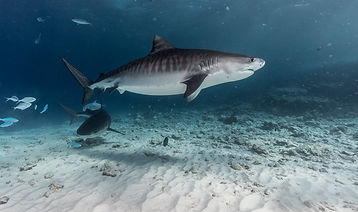
Research Publications

BRIEF RESEARCH REPORT articleFront. Mar. Sci. , 14 November 2024Sec. Marine MegafaunaVolume 11 - 2024 | https://doi.org/10.3389/fmars.2024.1500176
Identification of the first gestational ground for tiger sharks (Galeocerdo cuvier) in the Central Indian Ocean using a high-definition submersible ultrasound
James A. Sulikowski Nathan Perisic Arzucan Askin Lennart Vossgaetter Filippo Bocchi Hamna Hussain Ali Didi Ahmed Inah Tatiana Ivanova
The reproductive state of wild, free-swimming tiger sharks (Galeocerdo cuvier), was assessed using underwater ultrasonography at a diving site in Fuvahmulah, a Maldivian atoll within the central Indian Ocean. The presence of embryos were observed in 93% of the adult sharks (26/28) and two distinct embryonic size groups were observed within the subset of scanned adult females. The results suggest that the observed dive site functions as a gestation ground and builds upon previous work that emphasizes the importance of dive sites for the collection of biological data for shark conservation and management.

Non-invasive methods characterise the world’s largest tiger shark aggregation in Fuvahmulah,Maldives
Authors: Lennart Vossgaetter, Tim Dudeck, Jamie Crouch, Maiah Cope, Tatiana Ivanova, Ibrahim Siyan, Abdullah Niyaz, Mohamed Riyaz, & Gonzalo Araujo
This paper explores the unique aggregation of tiger sharks in Fuvahmulah, Maldives, documenting the population structure, residency patterns, and reproductive behaviors of these apex predators. Utilizing non-invasive methods such as photo identification and laser photogrammetry, the study provides an in-depth look at tiger sharks in this geographically restricted area. By focusing on the characteristics of this aggregation, the research aims to fill critical gaps in the understanding of tiger shark populations in the Indian Ocean. This study is a significant step toward improving conservation efforts for these iconic predators. The basement for tiger shark research in Fuvahmulah,

Behavioural Processes, Volume 229, 2025, 105216, https://doi.org/10.1016/j.beproc.2025.105216.
First insights into social behavioral patterns between pairs of bait-attracted mature female tiger sharks from Fuvahmulah Island, Maldives
Authors: Francesca Romana Reinero, Filippo Bocchi, Nathan Perisic, Jamie Crouch, Antonio Pacifico, Luca Asshauer, Consuelo Vicariotto, Primo Micarelli
Tiger sharks are predominantly known as solitary animals, yet their opportunistic and generalist predatory nature can drive interactions with conspecifics, including artificial provisioning sites. Underlying social dynamics may influence such instances of grouping behavior. Despite social behavior being an expanding niche in shark science, little is known about the social behavioral patterns of the tiger shark worldwide. Between 2023 and 2024 in Fuvahmulah Island, Maldives, 36 pair-wise non-random social interactions were observed at the provisioning site via video recordings by 40 photo-identified mature female tiger sharks. Social behaviors previously identified in white sharks and tiger sharks across multiple locations, such as give way, swim by, parallel swimming, follow give way, and stand back, have also been documented in tiger sharks from Fuvahmulah Island. Furthermore, this study presents two newly observed antagonistic social behaviors — submission and push away — described here for the first time. Within the mature female tiger shark aggregation in Fuvahmulah, a size-based hierarchy was observed, with certain individuals displaying the majority of dominance and social interactions. The asymmetry in the monthly display of social behaviors suggests an intra-specific variability of tiger shark movements to different home ranges. These findings deepen our knowledge of the tiger shark social behavior, highlighting data gaps in Maldives and ensuring effective conservation measures for this species. Recommendations for future research work at this site are also presented in this paper.


